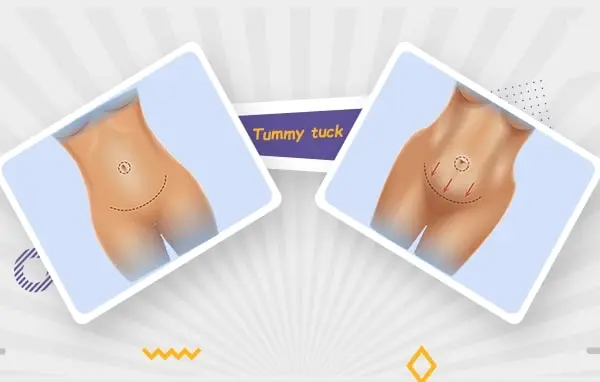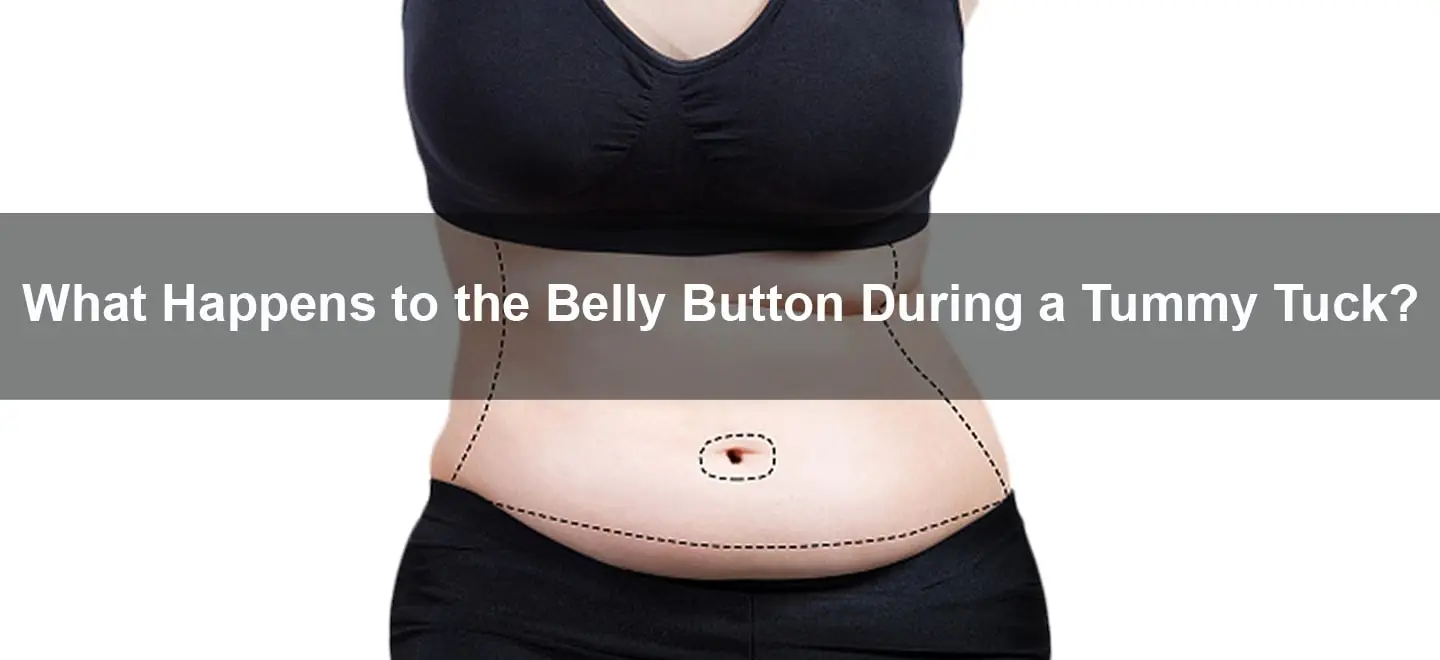What Happens to the Belly Button During a Tummy Tuck?
What Happens to the Belly Button During a Tummy Tuck?
A tummy tuck, or abdominoplasty, is a type of cosmetic surgery that removes excess fat and skin from the abdomen and tightens the muscles of the abdominal wall. The procedure is often used after pregnancy or weight loss, when the skin has become stretched or saggy. It results in a flatter, more contoured belly and, for many women, a more confident self-image. The belly button, or navel, is an important element in the appearance of the abdomen – but what happens to it during a tummy tuck? This article will show that the appearance and position of the belly button change during a tummy tuck surgery; describe the more common standard techniques to keep the position and describe the postoperative changes in the shape of the belly button; review some before and after pictures of the procedure. Finally, it will address the healing process after surgery, the post-surgery care, when to see a doctor and summarize the key takeaways.
Tummy tucks and the belly button
In an average day, your typical plastic surgeon will perform a variety of different cosmetic procedures. But ultimately, even if the surgeon does several tummy tucks in a day, the belly button remains the most defining feature of the tummy tuck procedure. This is because the belly button is effectively reset during a tummy tuck. This means that the original belly button – which is removed along with the excess skin from the upper abdomen – is used to create a new belly button that has been pulled out from the skin that is now tighter below the belly button. Although this may sound like quite a drastic process, by creating a new belly button in this way it allows for the upper skin of the tummy to be pulled down and made tight, which is the main goal of a tummy tuck. The main take away here is that the appearance of the belly button both before and after tummy tuck is going to be an important reference point when you’re talking about the final appearance of the abdomen as a whole. The location, size and shape of the belly button all play a key role in determining what sort of tummy tuck is best for a patient, and what the expected final result is going to be. For instance, if the surgeon is removing more skin from the upper abdomen when compared with the lower abdomen and creating more skin tightness above the belly button when compared with the lower abdomen, then you’d usually expect to see the belly button pulled down somewhat with the tummy tuck. The exception to this large scale shift in the overall abdominal skin occurs is when a procedure called a ‘float abdominoplasty’ is performed. This procedure is typically used in cases of revisional surgery or milder forms of tummy tuck and involves the creation of a new belly button without detaching the skin from it. Instead, the skin is simply released and made to float in a direction from the lower abdomen towards the top of the abdomen. This is a less invasive type of tummy tuck and uses the physical properties of the skin to reposition the belly button with minimal scarring and no need for suturing of the belly button itself.
Healing after surgery
Healing after surgery begins in the hospital. The patient will be transferred to a recovery room and will remain there as the anesthesia wears off. The patient will receive intravenous fluids until they can keep fluids down and will be monitored closely to make sure that infection, blood clots, or other complications do not occur. The surgeon will provide pain medication to help the patient remain comfortable during the first few days of recovery and antibiotics to reduce the risk of infection. Although the length of recovery depends on the patient, most people can return to work in two to four weeks. Strenuous activity, however, should be avoided until the muscles have time to heal – usually around two months. For the first few weeks after surgery, individuals are advised to sleep with their legs propped up, refrain from heavy lifting, and employ other techniques to reduce swelling and discomfort. It is common for the abdomen to feel at least somewhat numb for several months, and in some cases, this numbness may be permanent, although this is rare. Clearly, the healing process for tummy tuck surgery starts as soon as the surgeon finishes the operation and progresses over a period of several months to two years. During this time, supportive tissues grow and develop strength, and the abdomen becomes flatter, better toned, and more comfortable. However, to achieve the best possible result, a patient must follow all post-surgery instructions from the doctor and engage in appropriate post-care activities.
Post-surgery care
By about three months, the bulk of the swelling will have gone down, and also the scars will begin to heal, and by about six months, the scars will have softened and lightened in color. You ought to leave the dressings intact until your follow-up appointment with the clinician and avoid showering on your own until the clinician has indicated that it’s safe to try to do so. After your dressings are removed, you’ll have the ability to shower, but it’s important to stay your wounds clean. This usually involves employing a small handheld showerhead to gently direct a stream of water over the wounds beside using a light soap to clear away any crusting or dried blood. Be sure to pat your wounds dry with a clean towel and avoid drying washing because the fabric may leave fibers on the healing wounds. Always avoid vigorous rubbing when drying your wounds. Also, avoid bathing, swimming, soaking in water, and any activities that involve submerging the healing wounds once you have dressings in situ. It is vital to stay your wounds protected from sunlight, and avoiding sun exposure to your scars goes to be important within the first six months after abdominoplasty. The scars might darken and increase the danger of hyperpigmentation if exposed to the sun throughout this era. Always apply a high-factor sunblocker to the scars which may protect them from the sun’s harmful rays.
The day after your surgery, you’ll be advised to require a brief walk to assist stimulate blood flow, but you’ll be encouraged to require it easy and keep your back bent as this may reduce the strain on your wound and will help to scale back the danger of complications like swelling and fluid collections. Slowly and step by step, your mobility will return, and by about eight weeks, most of the people are back to traditional activities. You’ll be advised to avoid strenuous activities for extended, and it’s always best to create up your activity levels gradually.
Over the first few days following your tummy tuck and belly button surgery, you would possibly feel a touch weak, and it’ll be vital to require things easy. Depending on the sort of job you are doing, you’ll normally need to require one to three weeks off. It’s vital to avoid heavy lifting, strenuous activities, and long periods of standing for a minimum of six weeks after a tummy tuck. If you’ve got a physically demanding job, it’s recommended for your own comfort and also the best results from the surgery that you simply take longer off work.

When to see a doctor
The tummy tuck is a common cosmetic surgery, and it is a major surgery. You need to understand when it is necessary to visit a doctor. Immediately you sign of an infection, you need to contact your doctor. Infections linked to tummy tuck surgery tend to occur after five days, and therefore, during the first week of the surgery, the patient needs to thoroughly observe the healing process. If after five days you start to notice the sign of an infection such as increased pain, redness and general body weakness, you need to visit the doctor immediately. Also, if the patient notices that the wound is not healing properly, he needs to consult a doctor. It can be noted that a tummy tuck wound may dehisce, which means that the wound opens along the suture line. This can happen due to body movement, sleeping positions or constipation. However, if you see that the wound is not getting any better and dehiscence is taking place each and every day, you need to seek medical attention. Finally, if you also notice that the painkillers which were prescribed to you after the surgery are not working efficiently, you need to visit your doctor. When the patient starts to experience abnormal and severe pain, then that is a red flag that something is not going well in the body. It is important for the patient to express his concerns to the doctor because the doctor has a responsibility of helping you through the recovery process. Hence, you should not worry the doctor by calling them or scheduling an appointment to see him, even if you feel like your question or concern is negligible.
The bottom line
Will decrease when the patient stops losing weight. The muscle will also weaken the wear is not permanent. It will last longer if the patient does not gain any more wait after surgery. Also, there could be of swelling on the patient to experience varies from subtle to severe. There could be some persistent swelling of the lower abdomen after surgery. The final results of the tummy tuck surgery process may not be evident for 6 months or more. Some people say it takes about a year, but most will agree to wait at least the 6 months. Everyone heals at a different rate, so the additional time will allow the patient to recover before considering further tummy tuck process. A tummy tuck can boost the patient’s body image and self-esteem. Most people find that their self-image and mood improves almost immediately after the process. The abdomen will be flatter and firmer almost at once, and continued improvement will make the scars less noticeable and lift confidence for the patient. The patient’s scars will fade over time, but only to a point. This can take from 9 months to a year. The scars could be red, purple or even dark brown at first and they will fade to silvery lines as healing progresses. Their visibility will vary according to the patient’s skin types, skin color and sun exposure. Lastly, the patient may still see only drains in the area below the abdomen after about 5 to 7 days and the stitches will be taken out in 3 weeks. The patients may have some swelling on the lower end for up to 6 months. Most people can go back to work after 4 weeks and the patient will have to take it very easy for the first 3 weeks. The heaviest lifting can be done no less than 2 weeks after complete recuperation.

